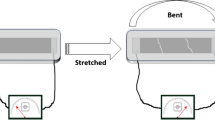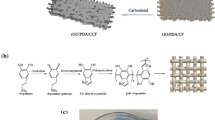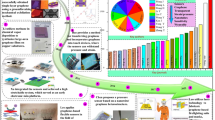Abstract
Applications of graphene-based materials in wearable devices have garnered significant attention owing to their excellent mechanical and electrical properties. However, graphene fabrication is hindered by its inherent structural characteristics, which necessitates the development of alternative materials for strain sensors. In this study, a novel flexible resistive-type strain sensor composed of a unique three-dimensional conductive carbon network was fabricated using a UV pulsed laser. Using a 355-nm UV pulsed laser, composites based on UV laser-reduced graphene oxide (UV-LRGO) with CuO nanoparticles on a PDMS substrate (Cu/UV-LRGO/PDMS) were selectively fabricated via direct laser writing. This fabrication method offers a contact-free, environmentally sustainable, and cost-effective approach, providing a streamlined one-step process that eliminates the necessity for toxic chemicals, thermal reduction, and complex protocols. The composites were meticulously characterized via various spectroscopic techniques. Notably, the proposed sensor exhibited robust performance, withstanding 7,200 stretching-relaxing cycles and accommodating strains of up to 25%, while also exhibiting a high strain gauge factor (~ 1026 GF). This work introduces a straightforward strategy for fabricating flexible strain sensors with high sensitivity and remarkable repeatability for human health monitoring, and observations including wrist pulses, finger banding, and facial eyebrow movements can be effectively monitored.







Similar content being viewed by others
Data Availability
The data presented in this study are available on request from the corresponding author.
References
Belleville, C., & Duplain, G. (1993). White-light interferometric multimode fiber-optic strain sensor. Optics Letters, 18(1), 78–80.
Kersey, A. D., Berkoff, T. A., & Morey, W. W. (1993). Multiplexed fiber Bragg grating strain-sensor system with a fiber Fabry-Perot wavelength filter. Optics Letters, 18(16), 1370–1372.
Zhou, F., Fu, X., Chen, S., Kim, E., & Jun, M. B. G. (2023). Fiber optic sensor for smart manufacturing. International Journal of Precision Engineering and Manufacturing, 1(2), 125–136.
Kang, I., Schulz, M. J., Kim, J. H., Shanov, V., & Shi, D. (2006). A carbon nanotube strain sensor for structural health monitoring. Smart Materials and Structures, 15, 737–748.
Yamade, T., Hayamizu, Y., Yamamoto, Y., Yomogida, Y., Izadi-Najafabadi, A., Futaba, D. N., & Hata, K. A. (2011). Stretchable carbon nanotube strain sensor for human-motion detection. Nature Nanotechnology, 6, 296–301.
Lee, J., Kim, S., Lee, J., Yang, D., Park, B. C., Ryu, S., & Park, I. (2014). A stretchable strain sensor based on a metal nanoparticle thin film for human motion detection. Nanoscale, 6, 11932–11939.
Ryu, S., Lee, P., Chou, J. B., Xu, R., Zhao, R., Hart, A. J., & Kim, S. G. (2015). Extremely elastic wearable carbon nanotube fiber strain sensor for monitoring of human motion. ACS Nano, 9(6), 5929–5936.
Roh, E., Hwang, B. U., Kim, D., Kim, B. Y., & Lee, N. E. (2015). Stretchable, transparent, ultrasensitive, and patchable strain sensor for human-machine interfaces comprising a nanohybrid of carbon nanotubes and conductive elastomers. ACS Nano, 9(6), 6252–6261.
Feng, W., Zheng, W., Gao, F., Chen, X. S., Liu, G., Hasan, T., Cao, W. W., & Hu, P. A. (2016). Sensitive electronic-skin strain sensor array based on the patterned two-dimensional α-In2Se3. Chemistry of Materials, 28(12), 4278–4283.
Chortos, A., Liu, J., & Bao, Z. (2016). Pursuing prosthetic electronic skin. Nature Materials, 15, 937–950.
Kim, S., Park, C. Y., Kim, C., Kim, H. C., & Lee, I. H. (2023). Design and characterization of flexible strain sensors using pressure-sensitive material with multi-walled carbon nanotubes and polydimethylsiloxane. International Journal of Precision Engineering and Manufacturing, 24(12), 2361–2369.
Harada, S., Honda, W., Arie, T., Akita, S., & Takei, K. (2014). Fully printed, highly sensitive multifunctional artificial electronic whisker arrays integrated with strain and temperature sensors. ACS Nano, 8(4), 3921–3927.
Kim, K. K., Hong, S., Cho, H. M., Lee, J., Suh, Y. D., Ham, J., & Ko, S. H. (2015). Highly sensitive and stretchable multidimensional strain sensor with prestrained anisotropic metal nanowire percolation networks. Nano Letters, 15(8), 5240–5247.
Wu, X., Han, Y., Zhang, X., & Lu, C. (2016). Highly sensitive, stretchable, and wash-durable strain sensor based on ultrathin conductive Layer@Polyurethane yarn for tiny motion monitoring. ACS Applied Materials & Interfaces, 8(15), 9936–9945.
Lee, C. J., Park, K. H., Han, C. J., Oh, M. S., You, B., Kim, Y. S., & Kim, J. W. (2017). Crack-induced Ag nanowire networks for transparent, stretchable, and highly sensitive strain sensors. Scientific Reports, 7, 7959.
Liu, H., Li, Y., Dai, K., Zheng, G., Liu, C., Shen, C., Yan, X., Guo, J., & Guo, Z. (2016). Electrically conductive thermoplastic elastomer nanocomposites at ultralow graphene loading levels for strain sensor applications. Journal of Materials Chemistry C, 4, 157–166.
Liu, Q., Chen, J., Li, Y., & Shi, G. (2016). High-performance strain sensors with fish-scale-like graphene-sensing layers for full-range detection of human motions. ACS Nano, 10(8), 7901–7906.
Zou, Y., Zhong, M., Li, S., Qing, Z., Xing, X., Gong, G., Yan, R., Qin, W., Shen, J., Zhang, H., & Jiang, Y. (2023). Flexible wearable strain sensors based on laser-induced graphene for monitoring human physiological signals. Polymers, 15(17), 3553.
Carvalho, A. F., Fernandes, A. J., Leitão, C., Deuermeier, J., Marques, A. C., Martins, R., Fortunato, E., & Costa, F. M. (2018). Laser-induced graphene strain sensors produced by ultraviolet irradiation of polyimide. Advanced Functional Materials, 28(52), 1805271.
Yu, H., Bian, J., Chen, F., Ji, J., & Huang, Y. (2023). Ultrathin, graphene-in-polyimide strain sensor via laser-induced interfacial ablation of polyimide. Advanced Electronic Materials, 9(9), 2201086.
Kulyk, B., Silva, B. F., Carvalho, A. F., Silvestre, S., Fernandes, A. J., Martins, R., Fortunato, E., & Costa, F. M. (2021). Laser-induced graphene from paper for mechanical sensing. ACS Applied Materials & Interfaces, 13(8), 10210–10221.
Chhetry, A., Sharifuzzaman, M., Yoon, H., Sharma, S., Xuan, X., & Park, J. Y. (2019). MoS2-decorated laser-induced graphene for a highly sensitive, hysteresis-free, and reliable piezoresistive strain sensor. ACS Applied Materials & Interfaces, 11(25), 22531–22542.
Chhetry, A., Sharma, S., Barman, S. C., Yoon, H., Ko, S., Park, C., Yoon, S., Kim, H., & Park, J. Y. (2021). Black Phosphorus@Laser-engraved graphene heterostructure-based temperature-strain hybridized sensor for electronic-skin applications. Advanced Functional Materials, 31(10), 2007661.
Yang, D., Nam, H. K., Le, T. S. D., Yeo, J., Lee, Y., Kim, Y. R., Kim, S. W., Choi, H. J., Shim, H. C., Ryu, S., & Kwon, S. (2023). Multimodal E-textile enabled by one-step maskless patterning of femtosecond-laser-induced graphene on nonwoven, knit, and woven textiles. ACS Nano, 17(19), 18893–18904.
Stankovich, S., Dikin, D. A., Dommett, G. H. B., Kohlhaas, K. M., Zimney, E. J., Stach, E. A., Piner, R. D., Nguyen, S. T., & Ruoff, R. S. (2006). Graphene-based composite materials. Nature, 2006(442), 282–286.
Castro Neto, A. H., Guinea, F., Peres, N. M. R., Novoselov, K. S., & Geim, A. K. (2009). The electronic properties of graphene. Reviews of Modern Physics, 81(1), 109–162.
Schwierz, F. (2010). Graphene transistor. Nature Nanotechnology, 5, 487–496.
Tan, R. K. L., Reeves, S. P., Hashemi, N., Thomas, D. G., Kavak, E., Montazami, R., & Hashemi, N. N. (2017). Graphene as a flexible electrode: Review of fabrication approaches. Journal of Materials Chemistry A, 5, 17777.
Yu, H., Zhang, B., Bulin, C., Li, R., & Xing, R. (2016). High-efficient synthesis of graphene oxide based on improved hummers method. Science and Reports, 6, 34163.
Chen, J., Duan, M., & Chen, G. (2012). Continuous mechanical exfoliation of graphene sheets via three-roll mil. Journal of Materials Chemistry, 22, 19625.
Losurdo, M., Giangregorio, M. M., Capezzuto, P., & Bruno, G. (2011). Graphene CVD growth on copper and nickel: Role of hydrogen in kinetics and structure. Physical Chemistry Chemical Physics: PCCP, 13, 20836–20843.
Yang, W., Chen, G., Shi, Z., Liu, C. C., Zhang, L., Xie, G., Cheng, M., Wang, D., Yang, R., Shi, D., Watanabe, K., Taniguchi, T., Yao, Y., Zhang, Y., & Zhang, G. (2013). Epitaxial growth of single-domain graphene on hexagonal boron nitride. Nature Materials, 12, 792–797.
Vanin, M., Mortensen, J. J., Kelkkanen, A. K., Garcia-Lastra, J. M., Thygesen, K. S., & Jacobsen, K. W. (2010). Graphene on metals: A van der Waals density functional study. Physical Review B, 81, 081408.
Koenig, S. P., Boddeti, N. G., Dunn, M. L., & Bunch, J. S. (2011). Ultrastrong adhesion of graphene membranes. Nature Nanotechnology, 6, 543–546.
Lee, J. H., Avsar, A., Jung, J., Tan, J. U., Watanabe, K., Taniguchi, T., Natarajan, S., Eda, G., Adam, S., Castro Neto, A. H., & Ozyilmaz, B. (2015). Nano Letters, 15(1), 319–325.
Li, J., & Ostling, M. (2013). Prevention of graphene restacking for performance boost of supercapacitors—a review. Crystals, 3(1), 163–190.
Zhu, W., Low, T., Perebeinos, V., Bol, A. A., Zhu, Y., Yan, H., Tersoff, J., & Avouris, P. (2012). Structure and electronic transport in graphene wrinkles. Nano Letters, 12(7), 3431–3436.
Yang, X., Zhu, J., Qiu, L., & Li, D. (2011). Bioinspired effective prevention of restacking in multilayered graphene films: Towards the next generation of high-performance supercapacitors. Advanced Materials, 23, 2833–2838.
Peng, H., Li, F., Hua, Z. H., Yang, K., Yin, F., & Yuan, W. (2018). Highly sensitive and selective room-temperature nitrogen dioxide sensors based on porous graphene. Sensors and Actuators, B: Chemical, 275, 78–85.
Pang, Y., Jian, J., Tu, T., Yang, Z., Ling, J., Li, Y., Wang, X., Qiao, Y., Tian, H., Yang, Y., & Ren, T. L. (2018). Wearable humidity sensor based on porous graphene network for respiration monitoring. Biosensors & Bioelectronics, 116, 123–129.
Xia, K., Wang, C., Jian, M., Wang, Q., & Zhang, Y. (2018). CVD growth of fingerprint-like patterned 3D graphene film for an ultrasensitive pressure sensor. Nano Research, 11, 1124–1134.
Rahim, R., Ochoa, M., Yu, W., & Ziaie, B. (2015). Highly stretchable and sensitive unidirectional strain sensor via laser carbonization. ACS Applied Materials & Interfaces, 7(8), 4463–4470.
Yang, Z., Wnag, D. Y., Pang, Y., Li, Y. X., Wang, Q., Zhang, T. Y., Wang, J. B., Liu, X., Yang, Y. Y., Jian, J. M., Jian, M. Q., Zhang, Y. Y., Yang, Y., & Ren, T. L. (2018). Simultaneously detecting subtle and intensive human motions based on a silver nanoparticles bridged graphene strain sensor. ACS Applied Materials & Interfaces, 10(4), 3948–3954.
Trung, T. Q., Tien, N. T., Kim, D., Jang, M., Yoon, O. J., Lee N. E. (2013). A flexible reduced graphene oxide field-effect transistor for ultrasensitive strain sensing. Advanced Functional Materials, 24(1), 117–124.
Gao, J., Li, B., Huang, X., Wang, L., Lin, L., Wang, H., & Xue, H. (2019). Electrically conductive and fluorine free superhydrophobic strain sensors based on SiO2/graphene-decorated electrospun nanofibers for human motion monitoring. Journal of Chemical Engineering, 3, 298–306.
Sun, B., McCay, R. N., Goswami, S., Xu, Y., Zhang, C., Ling, Y., Lin, L., & Yan, Z. (2018). Gas-permeable, multifunctional on-skin electronics based on laser-induced porous graphene and sugar-templated elastomer sponges. Advanced Materials, 30, 1804327.
Hummers, W. S., Jr., & Offeman, R. E. (1958). Preparation of graphitic oxide. Journal of the American Chemical Society, 80(6), 1339.
Bagri, A., Mattevi, C., Acik, M., Chabal, Y. J., Chhowalla, M., & Shenoy, V. B. (2010). Structural evolution during the reduction of chemically derived graphene oxide. Nature Chemistry, 2, 581–587.
Hwang, Y. T., & Kim, H. S. (2022). The ultrafast and eco-friendly reduction of graphene oxide using a UV–IR assisted intense pulsed light and its application as supercapacitor. International Journal of Precision Engineering and Manufacturing, 9, 201–211.
Huang, X., Zhan, G., & Wang, X. (2015). Fabrication of reduced graphene oxide/metal (Cu, Ni, Co) nanoparticle hybrid composites via a facile thermal reduction method. RSC Advances, 2015(5), 49973–49978.
Guardia, L., Villar-Rodlil, S., Paredes, J. I., Rozada, R., Martinez-Alonso, A., & Tascon, J. M. D. (2012). UV light exposure of aqueous graphene oxide suspensions to promote their direct reduction, formation of graphene–metal nanoparticle hybrids and dye degradation. Carbon, 50(3), 1014–1024.
Bhattacharya, S., Datta, A., & Berg, J. (2005). Gangopadhyay, S. Studies on surface wettability of poly (dimethyl) siloxane (PDMS) and glass under oxygen-plasma treatment and correlation with bond strength. Journal of Microelectromechanical Systems, 14, 590–597.
Hillborg, H., Ankner, J., Gedde, U., & Smith, G. (2000). Crosslinked polydimethylsiloxane exposed to oxygen plasma studied by neutron reflectometry and other surface specific techniques. Polymer, 41, 6851–6863.
Marcano, D. C., Kosynkin, D. V., Berlin, J. M., Sinitskii, A., Sun, Z., Slesarev, A., Alemany, L. B., Lu, W., & Tour, J. M. (2010). Improved synthesis of graphene oxide. ACS Nano, 4(8), 4806–4814.
Wroblewska, A., Duzynska, A., Judek, J., Stobinski, L., Zeranska, K., Gertych, A. P., & Zdrojek, M. (2017). Statistical analysis of the reduction process of graphene oxide probed by Raman spectroscopy mapping. Journal of Physics: Condensed Matter, 29(47), 475201.
Saito, R., Furukawa, M., Dresselhaus, G., & Dresselhaus, M. S. (2010). Raman spectra of graphene ribbons. Journal of Physics: Condensed Matter, 22(33), 334203.
Scardaci, V., Compagnini, G., & Raman. (2021). Spectroscopy data related to the laser induced reduction of graphene oxide. Data in Brief, 38, 107306.
Svintsitskiy, D. A., Kardash, T. Y., Stonkus, O. A., Slavinskaya, E. M., Stadnichenko, A. I., Koscheev, S. V., Chupakhin, A. P., & Boronin, A. I. (2013). In situ XRD, XPS, TEM, and TPR study of highly active in CO oxidation CuO nanopowders. Journal of Physical Chemistry C, 117(28), 14588–14599.
Sahai, A., Goswami, N., Kaushik, S. D., & Tripathi, S. (2016). Cu/Cu2O/CuO nanoparticles: Novel synthesis by exploding wire technique and extensive characterization. Applied Surface Science, 390, 974–983.
Acknowledgements
Natural Sciences and Engineering Research Council of Canada (NSERC) under Discovery Grant RGPIN-2019-05778. This work was supported by the Technology Innovation Program (P0008763) funded by the (MOTIE, Korea). This research was supported by a grant of the Korea Health Technology R&D Project through the Korea Health Industry Development Institute (KHIDI), funded by the Ministry of Health &Welfare, Republic of Korea (grant number : HI19C1085).
Funding
Natural Sciences and Engineering Research Council of Canada (NSERC) under Discovery Grant RGPIN-2019–05778. This work was supported by the Technology Innovation Program (P0008763) funded by the (MOTIE, Korea). This work was supported by the National Research Foundation of Korea (NRF) grant funded by the Korea government (MSIT) (No.2022R1A5A2027161).
Author information
Authors and Affiliations
Contributions
J.-U.L.; B.-S.K.; methodology, J.-U.L., B.-S.K. and S.-C.C.; software, J.-U.L.; B.-S.K.; and S.-C.C.; validation, J.-U.L. formal analysis, J.-U.L. and B.-S.K.; investigation, B.-S.S.; resources, J.-U.L. and P.C.L.; data curation, J.-U.L.; B.-S.K. and S.-C.C.; writing—original draft preparation, J.-U.L., B.-S.K. and S.-C.C.; writing—review and editing, P.C.L.; B.-S.S.; visualization, J.-U.L., P.C.L.; supervision, P.C.L, B.-S.S.; project administration, P.C.L.; B.-S.S.; funding acquisition, P.C.L.; B.-S.S. All authors have read and agreed to the published version of the manuscript.
Corresponding authors
Ethics declarations
Competing Interests
The authors declare no conflicts of interest.
Additional information
Publisher's Note
Springer Nature remains neutral with regard to jurisdictional claims in published maps and institutional affiliations.
Supplementary Information
Below is the link to the electronic supplementary material.
Rights and permissions
Springer Nature or its licensor (e.g. a society or other partner) holds exclusive rights to this article under a publishing agreement with the author(s) or other rightsholder(s); author self-archiving of the accepted manuscript version of this article is solely governed by the terms of such publishing agreement and applicable law.
About this article
Cite this article
Lee, JU., Kang, BS., Cho, SC. et al. Facile Fabrication of Highly Flexible and Sensitive Strain Sensors Based on UV-laser-reduced Graphene Oxide with CuO Nanoparticles for Human Health Monitoring. Int. J. of Precis. Eng. and Manuf.-Green Tech. (2024). https://doi.org/10.1007/s40684-024-00632-w
Received:
Revised:
Accepted:
Published:
DOI: https://doi.org/10.1007/s40684-024-00632-w




